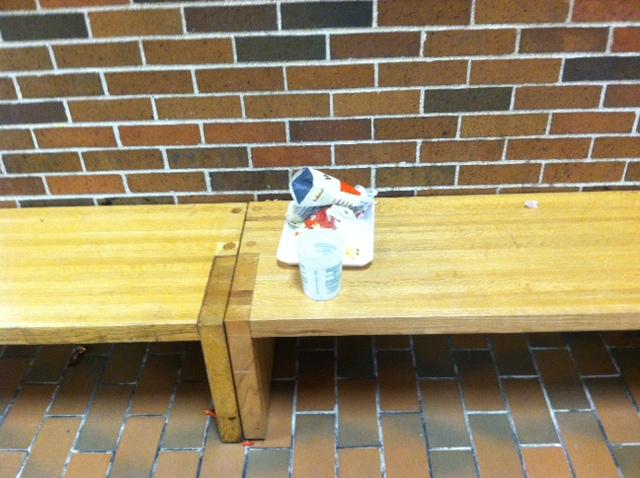
The tunnels in RBHS’s lower level are now closed during A and B lunches, preventing students from sitting and eating in this area during their allotted half hour eating period. The administration announced the change last week, officially implementing the new rule on March 10.
Assistant principal Brian Gaub said he perceives the policy as a way to reduce the amount of space janitors must clean after lunch. Because the school has such a large amount of available square footage, which students may utilize freely during their lunch time, closing down the tunnels will ease the demand placed on janitorial staff.
“My perspective on closing off the tunnels is that it minimizes the amount of space that the custodians have to clean up at lunch,” Gaub said. “There’s not any more trash in the tunnel than there are in other areas, but it is one of the areas we can close off, because as it is, there’s trash in so many different parts of the building that after lunch they’re having to clean such a large area and they don’t have a really big staff during the day.”
Head custodian Janice Brunstrom said trash left behind by students during lunch poses an increasingly prevalent problem for the custodial staff. She has picked up trays, bottles and milk cartons from nearly every area of the school, including elevators and gym bleachers.
“We have all the lunchroom, all the commons, all of the east atrium, a lot of the classrooms that [students] are allowed to eat in,” Brunstrom said. “You have the think about the abundant amount of trash we’re pulling out of here every day. But it’s not just in one area, it’s everywhere.”
The liberties granted to students in the form of lunch time freedom are imperative to the school culture, Brunstrom said. However, the notorious RBHS motto is important for students to remember when choosing a place to eat during lunch.
“I think it’s absolutely great that this school gives the young adults here the opportunity to have the freedom to eat wherever they want,” Brunstrom said. “I think that’s awesome. But I think with freedom comes responsibility, so if you want this freedom, you need to be able to be responsible and understand that when you leave those trays on the ground, the next group of kids coming to class might step on that tray, and milk might be spilled and someone might fall and get hurt.”
Photos provided by RBHS head custodian Janice Burnstrom
[slider source=”media: 261026,261029,261028,261027″ limit=”4″ target=”blank” height=”340″ title=”no” centered=”no” mousewheel=”no” speed=”500″]
The problem with students’ littering is evident throughout the school, Gaub said. The administration is currently working to lessen the vast amount of space where students may leave their trays and leftovers after lunch.
“There’s always trash,” Gaub said. “If you walk around at lunch time, you’ll find it in various areas and it kind of moves around a little bit. We try and manage it and create less square footage for them to try and clean. “
Brunstrom, however, does not believe the recent closing off of the tunnels will be enough to make an impact on the arduous amount of work required by janitors to clean up students’ trash following A and B lunch periods. She suggested the administration hire a lunch time supervisor who could patrol the hallways and encourage students to clean up after themselves.
“Blocking off that little tiny student hallway, if you ask me, is not going to make any difference. I understand they leave trash there, but it’s not that much of a hallway. What I asked for was maybe getting someone hired that has the authority to say to the students– because [custodians] do not– ‘you need to pick that up.’”
In the mean time, students can play a huge part in easing the demands of the custodial staff, Brunstrom said. By simply throwing his or her repective trash away at the end of each lunch period, kids can help out custodians while keeping a safer environment throughout the school.
“If we could get the students to just help us a little, alll we’re asking is that if they pick their lunch trays up, then we wouldn’t have to worry about if there was a spill and someone fell and got hurt,” Brunstrom said. “We’re perfectly fine with cleaning the building– sweeping it, mopping it, doing our job. All we’re asking is if the students could just please pick up their lunch trays and put them in the trash cans, not only to help us out but for safety reasons.”
By Anna Wright













































































